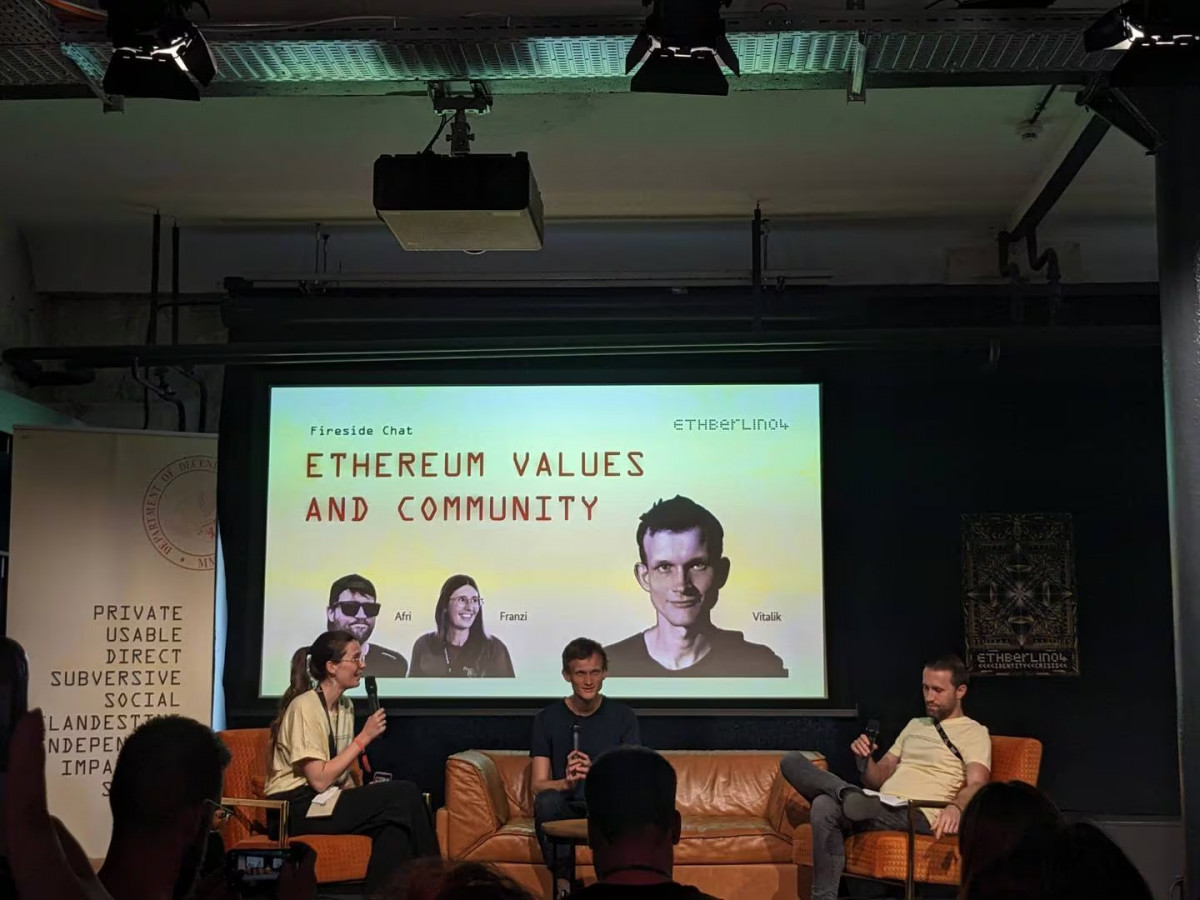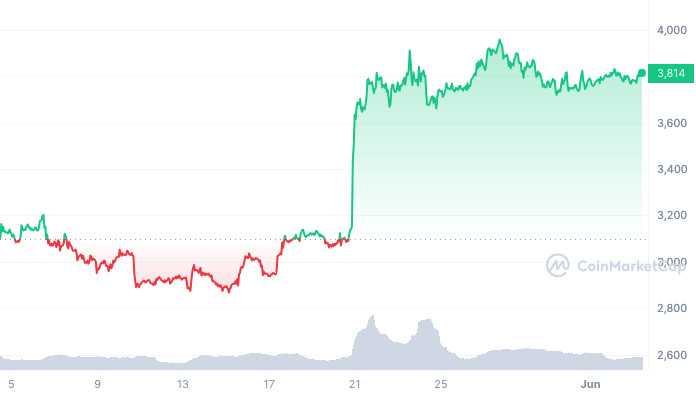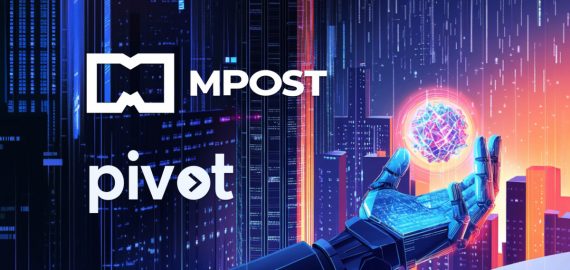Vitalik Buterin Optimistic About Ethereum’s Future Despite Past Flaws, Commends Core Developers’ Growing Execution Capacity


In Brief
At ETHBerlin 2023, Ethereum co-founder Vitalik Buterin visited over 600 developers, discussing Ethereum’s history and reimagining the blockchain system if he had to start over.
Over six hundred developers were thrilled to see the unforeseen arrival of Ethereum co-founder and main architect Vitalik Buterin at ETHBerlin 2023. During an open conversation with Afri Schoedon and Franziska Heintel, the conference organizers, Buterin discussed the history of Ethereum from 2014 and offered his thoughts on how he would reimagine the groundbreaking blockchain system if he had to start over now.
His remarks were made at a critical juncture for Ethereum, whose mainstream acceptance is quickly gathering momentum. The first spot Ethereum exchange-traded fund was approved by the US just now, and banking behemoth BlackRock debuted its own tokenized Ethereum fund on the blockchain. However, Buterin admitted that Ethereum lacks the straightforward virtual gold story of Bitcoin and is still frequently misinterpreted.
While reflecting on the early days of Ethereum in Berlin, working with Gavin Wood and Jeffrey Wilcke, Buterin was not afraid to point out flaws in the initial Ethereum architecture. Buterin listed five crucial topics he would review when answered directly by Schoedon about how he would develop Ethereum nowadays with the advantage of retrospect.
Buterin on the Processing of Virtual Machines at Suboptimal Level
The very first item on Buterin’s list was the EVM, the fundamental invention that enables Ethereum to operate as a decentralized supercomputer for the execution of dApps and smart contracts. He acknowledged that the 256-bit processing that was initially incorporated into the EVM’s architecture was an overly complex approach that led to unneeded bloating and ineffectiveness, even for the most basic functions.
For 256-bit, the first design was far too over-fitted. Buterin said rather simply. In hindsight, he thinks Ethereum ought to have debuted with a lighter 64- or 32-bit architecture, more suited for the network’s requirements during those early stages. At the time point, the 256-bit computing power was superfluous.

Photo: Liam Kelly/DL News.
Ethereum’s Founder Talks About Increased Clarity in Smart Contracts
Buterin also took issue with Ethereum’s methodology for creating smart contracts. Despite being hailed as one of Ethereum’s key inventions, smart contracts’ intricacy and absence of standards have always been problems. Since smart contracts can have countless pieces of code, it may be quite challenging for third parties to review and confirm that the contracts are performing exactly as intended.
Buterin said earlier that Ethereum’s developers ought to have put more effort into creating best practices and standards for smart contracts that prioritize openness and simplicity. He clarified that individuals can observe and verify what’s happening inside of them with fewer lines of code.
Vitalik Buterin’s Concerns on Using Proof-of-Stake Too Soon
Buterin’s strongest analysis of himself may have focused on Ethereum’s switch from a Proof-of-Work (PoW) consensus mechanism to a Proof-of-Stake (PoS) one. The difficult multi-year endeavor of creating and implementing PoS reached its zenith with the September 2022 Merge event, which effectively resolved Ethereum’s sustainability concerns caused by the costly and not sustainable PoW mining procedure.
Buterin stated that he thinks the Ethereum team grew overly meticulous about the changeover and lost the chance to introduce a stopgap step with a more basic PoS decades sooner. He said rather frankly that they might have preserved a lot of computer power in 2018 if they had gone with a much simpler Proof-of-Stake.
Buterin About Ethereum’s Hash Functions and Ignoring Crucial Logging Requirements
Buterin also regretted Ethereum’s choice to employ the Keccak hash function rather than the SHA-2 standard on a technical level. This may seem like a little detail, but it meant that Ethereum needed specific programs to support both SHA-3, which Keccak eventually replaced, and Keccak itself.
Buterin clarified that they needed to maintain both algorithms in the EVM as they were incompatible with other systems that used SHA-3. While this has been mostly fixed over time, he noted that in the bigger picture of items, it is not really important.
Lastly, Buterin voiced concern for not having tracked operations, particularly transfers of Ether between wallets, more effectively from the beginning by incorporating specific logging features from the start of Ethereum. With the introduction of smart contract wallets and enhanced privacy in Ethereum, some of this integrated logging has been erased.
Buterin estimated that it may have required thirty minutes of coding. Rather, it evolved into an Ethereum Improvement Proposal, or EIP. EIP-7708, which he just presented, will address this oversight.
Ethereum’s Founder on Growing Pains of Ethereum With a Promising Future
Even though Buterin voiced complaints over Ethereum’s original architecture, he remained essentially positive about the platform’s future direction and the skills of its core development team. He expressed his satisfaction with the core developers and their yearly growth in execution capability, saying they were now able to safely and efficiently fix some of these errors.
In fact, Buterin’s disclosures provide insight into how Ethereum developed from an audacious experiment to become the leading blockchain for Web3 apps, non-fungible tokens (NFTs), and decentralized finance (DeFi). The network has generated financial applications valued at over $63 billion and is becoming more widely accepted. Notably, large firms such as BlackRock have invested in the network.
Ethereum is clearly going through growing pains, though, since the proof-of-stake validation procedure is having problems with centralized and systemic risk. Over 20% of total Ethereum is staked by a small number of providers, such as Lido, and validator counts are rising to perhaps excessive levels on dependent systems that permit re-staking.

Photo: Ethereum price, CoinMarketCap
Concerns about impending regulations also cast a shadow. The SEC is becoming more and more hostile to cryptocurrencies. Therefore, we can see that the situation with a spot Ethereum ETF is not 100% clear right now. This may lead to more ETH sell-offs relative to Bitcoin as investors’ access to Ethereum is increasingly restricted.
Buterin’s openness and readiness to question Ethereum’s founding choices throughout demonstrate the project’s openness and dedication to continuous development. Even while he may not agree with some parts of Ethereum’s initial design, Buterin and the group of “core devs” whose abilities he complimented seem more than willing to take on the task of making amends.
Buterin has given an open path for Ethereum’s future development that adheres to its decentralized, community-driven philosophy by critically examining and reevaluating the platform’s original architectural decisions. Ethereum may still be “misunderstood” on a daily basis, as Buterin says, but things are starting to get clearer thanks to the company’s top architect’s self-awareness and straightforward purpose.
Disclaimer
In line with the Trust Project guidelines, please note that the information provided on this page is not intended to be and should not be interpreted as legal, tax, investment, financial, or any other form of advice. It is important to only invest what you can afford to lose and to seek independent financial advice if you have any doubts. For further information, we suggest referring to the terms and conditions as well as the help and support pages provided by the issuer or advertiser. MetaversePost is committed to accurate, unbiased reporting, but market conditions are subject to change without notice.
About The Author
Victoria is a writer on a variety of technology topics including Web3.0, AI and cryptocurrencies. Her extensive experience allows her to write insightful articles for the wider audience.
More articles

Victoria is a writer on a variety of technology topics including Web3.0, AI and cryptocurrencies. Her extensive experience allows her to write insightful articles for the wider audience.

















































